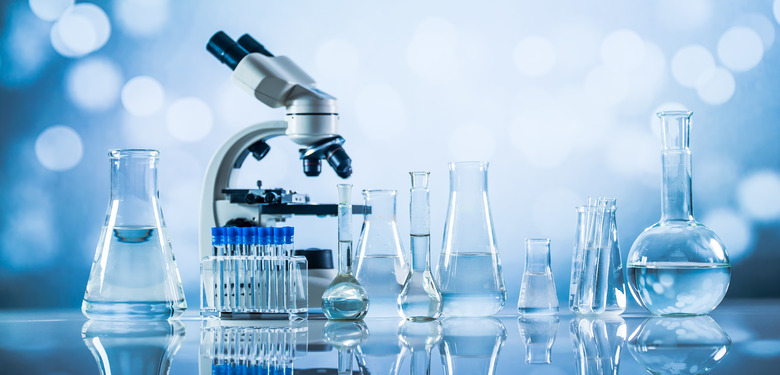Common Physics Laboratory Apparatus
The equipment found in physics laboratories varies in relation to the focus of research. Apparatus in physics laboratories may range from simple balances to lasers and specialized semiconductor instruments. Computational analysis, and therefore computation equipment, has also become essential to physics research. Physics laboratory apparatus aid in determining measurements, calibration, physical property variations and precision.
TL;DR (Too Long; Didn't Read)
Modern physics laboratories contain apparatus used in determining measurements, calibration, analysis of variations and precision. The focus of the laboratory's research determines the required apparatus. Instruments range from simple balances and thermometers to advanced lasers and semiconductor equipment.
General Laboratory Equipment
General Laboratory Equipment
The most basic physics laboratory equipment includes fume hoods, desks, tables, benches and gas, water and vacuum lines. Safety equipment may include gloves, goggles and eyewash stations.
Analyzer Instruments
Analyzer Instruments
Numerous instruments perform analysis on samples in physics laboratories. Some examples include impedance analyzers, particle analyzers, optical multichannel analyzers, semiconductor parameter analyzers, spectrum analyzers, capacitance-voltage (CV) analyzers, and X-ray diffractometers for characterizing crystalline materials and identifying phases.
Atomic Physics Equipment
Atomic Physics Equipment
Atomic physics laboratories contain unique apparatus. These may include saturation absorption spectroscopy, RF optical pumping and pulsed NMR.
Computing Equipment and Software
Computing Equipment and Software
Physics laboratories rely heavily on computing equipment and software for analysis of data. For astrophysics, cosmology and astroparticle physics research, powerful computing and simulations are required. Some common types of software used in labs include:
- MATLAB
- Python
- IDL
- Mathematica
- Fiji
- Origin
- LabView
Quantitative image and data analysis software prove invaluable in physics laboratories. In addition to personal computers, 3D printers, Arduinos and Raspberry Pis are useful technological devices.
Electrical Equipment
Electrical Equipment
A number of apparatus aid in electrical work in physics laboratories. In addition to the CV analyzer, other instruments include variable transformers (variacs), lock-in amplifiers and piezoelectric actuators. Many electrical apparatus such as the variac require special rubber gloves to protect the user from dangerous high voltage.
Heating Elements
Heating Elements
Occasionally physics laboratories require heat sources for experiments, particularly for thermodynamics study. A hot plate represents the simplest heating element. Electric furnaces are also prevalent. Additionally, gas furnaces may be used to reach high temperatures. Vacuum furnaces provide the ability to dry reagents. Insulated safety gloves and tongs provide necessary protection for these apparatus.
Laser Apparatus
Laser Apparatus
HeNe lasers are used in optics experiments. These require safety goggles to protect the eyes. Other laser apparatus in physics laboratories include fiber-coupled lasers, tunable diode lasers, etalons and optical beam steering devices.
Materials Processing and Testing
Materials Processing and Testing
Raw or manufactured samples in the physics laboratory merit various tools for processing. Physicists sometimes use a mortar and pestle to grind samples. Other processing implements include polishers, micronizing mills, sonicators, ultracentrifuges, nanomechanical test instruments and other materials testing apparatus. A hydraulic press and stainless steel die set may be used in making pellet samples for property measurements.
Measurement Tools
Measurement Tools
Physics laboratories require apparatus to ensure accurate measurements. Even meter sticks play a role. Additional measuring tools include thermometers, electrical meters, electronic balances, stylus profilometers, ellipsometers and magnetostriction measurement systems. An analytical balance is used for solid-state method measurements.
Microscopy and Imaging Apparatus
Microscopy and Imaging Apparatus
Microscopes handle the imaging in physics laboratories. Biophysics labs may use fluorescence microscopes and bright field microscopes. Materials can be studied with scanning electron microscopes, light-sheet fluorescence microscopes, digital holographic microscopes and electrically tunable lenses.
Other commonly used imaging equipment includes digital cameras and specialized high-speed CMOS cameras.
Photonics Equipment
Photonics Equipment
In biophysics laboratories, optical tweezers are used to manipulate individual molecules of DNA. These also aid in measuring bimolecular forces.
Plasma Equipment
Plasma Equipment
Laboratories studying ion dynamics require specialized equipment that may include Langmuir and emissive probes, plasma cleaners, low-temperature plasma confinement equipment, wave launching grids and plasma source ion implantation (PSII) chambers. The PSII chamber can extend product life.
Semiconductor Equipment
Semiconductor Equipment
Semiconductor laboratories use unique systems and devices. These include deep-level transient spectroscopy systems, CLEO cones for silicon detectors (which provide cooling for detector electronics and support for silicon detectors), microwave probe systems, photodiodes and optical amplifiers.
Thin-Film Equipment
Thin-Film Equipment
Thin-film equipment in physics laboratories includes the dual ion beam sputtering system, filmetrics devices and secondary ion mass spectrometer (SIMS). The SIMS analyzes sample spots for isotopic composition with precision up to 100 parts per million.
References
- Lahore University of Management Sciences: Physics Laboratory Safety Handout
- Texas State University College of Science and Engineering – Department of Physics: Alphabetical List of Equipment
- University of Wisconsin-Madison Physical Sciences Lab: Lab Equipment and Research Tools
- University of North Florida: Laboratory Equipment
Cite This Article
MLA
Hermance, Dianne. "Common Physics Laboratory Apparatus" sciencing.com, https://www.sciencing.com/common-physics-laboratory-apparatus-7436950/. 14 May 2018.
APA
Hermance, Dianne. (2018, May 14). Common Physics Laboratory Apparatus. sciencing.com. Retrieved from https://www.sciencing.com/common-physics-laboratory-apparatus-7436950/
Chicago
Hermance, Dianne. Common Physics Laboratory Apparatus last modified August 30, 2022. https://www.sciencing.com/common-physics-laboratory-apparatus-7436950/
